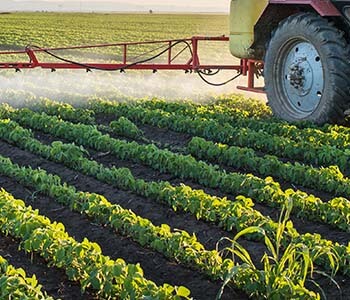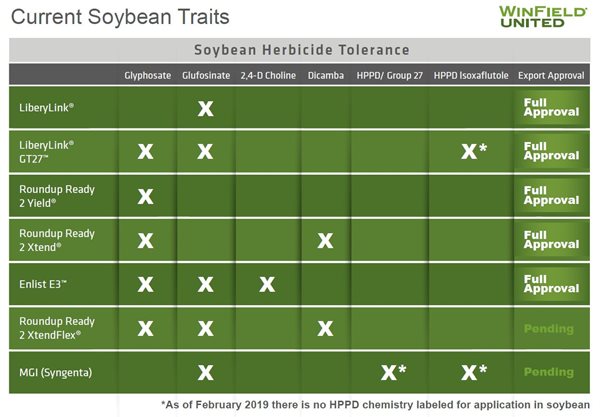June 2019 Key Discussion Points
Jun 05, 2019

Sulfur on Soybeans - Sulfur is required by the rhizobia bacteria in legumes for nitrogen fixation. Some growers get sulfur with the starter blend they are applying at planting. Others are still pulling from sulfur in the soil that may have carried over from a previous crop. Tissue tests can indicate whether you are providing your soybean crop with enough sulfur. Under irrigation, sulfur can be applied via fertigation with a shot of Nitrogen at Bloom.
Overlapping Residual Products in Soybeans – Soybeans often get overlooked when it comes to split applying or overlapping residual herbicides. With new technology like Extend and Enlist soybeans on the market, it is easy to assume that you can clean up weeds later in the season with no problem. Recent discoveries of dicamba and 2,4-D resistant weeds tell a different story. We can help avoid exasperating these problems by applying a PRE emerge residual product followed by another residual product early POST in soybeans. If your soybeans have been in more than 2 weeks, it’s time to be preparing to get your second product applied.
Soybean Traits on the Market – Speaking of new soybean technology, the options out there can be confusing at times. Use the chart below for more information on what products can be used on each trait package. Be sure that your agronomist or chemical applicator is fully aware of what type of soybeans you have planted and where they are location to avoid a herbicide application issue.

Early Tissue Testing on Corn – As corn reaches V5 or 5 collared leaf stage, it is moving into some critical growth periods. Around V5 corn starts relying on the root system to acquire nutrients. Until this point, the corn has mostly relied on the corn seed for its nutrition. Also, at V5-V6 stage, a corn plant is determining how many kernels around the ear will have. Stress and nutrient issues at this stage can greatly impact final harvest yield. This is a good time to have Tissue Tests pulled and analyzed. The results can help you determine what needs to be added for the upcoming rapid growth period through the reproductive stages.
Early Fungicide on Corn – Planting conditions have been challenging to put things lightly. The corn that was planted before the rain has struggled to avoid drowning out, cool soil temps, cloudy weather, etc. Laying residual products can help avoid unwanted weed pressure, another potential challenge for this smaller corn. With the Early POST application of residual herbicide, consider adding a fungicide to the tank. Fungicide applied near the V5 stage can increase or protect yield by helping mitigate stress when the plant is determining number of kernels around the ear. This application of fungicide can help with overall plant health and drought stress tolerance (we will turn off hot and dry at some point). However, do not plan to apply fungicide at V5 and then walk away for the season. Later planted corn will more than likely have to face Southern Rust late in the season, so a VT (Tassel) application will most likely also be important this year.
Overlapping Residual Products in Soybeans – Soybeans often get overlooked when it comes to split applying or overlapping residual herbicides. With new technology like Extend and Enlist soybeans on the market, it is easy to assume that you can clean up weeds later in the season with no problem. Recent discoveries of dicamba and 2,4-D resistant weeds tell a different story. We can help avoid exasperating these problems by applying a PRE emerge residual product followed by another residual product early POST in soybeans. If your soybeans have been in more than 2 weeks, it’s time to be preparing to get your second product applied.
Soybean Traits on the Market – Speaking of new soybean technology, the options out there can be confusing at times. Use the chart below for more information on what products can be used on each trait package. Be sure that your agronomist or chemical applicator is fully aware of what type of soybeans you have planted and where they are location to avoid a herbicide application issue.

Early Tissue Testing on Corn – As corn reaches V5 or 5 collared leaf stage, it is moving into some critical growth periods. Around V5 corn starts relying on the root system to acquire nutrients. Until this point, the corn has mostly relied on the corn seed for its nutrition. Also, at V5-V6 stage, a corn plant is determining how many kernels around the ear will have. Stress and nutrient issues at this stage can greatly impact final harvest yield. This is a good time to have Tissue Tests pulled and analyzed. The results can help you determine what needs to be added for the upcoming rapid growth period through the reproductive stages.
Early Fungicide on Corn – Planting conditions have been challenging to put things lightly. The corn that was planted before the rain has struggled to avoid drowning out, cool soil temps, cloudy weather, etc. Laying residual products can help avoid unwanted weed pressure, another potential challenge for this smaller corn. With the Early POST application of residual herbicide, consider adding a fungicide to the tank. Fungicide applied near the V5 stage can increase or protect yield by helping mitigate stress when the plant is determining number of kernels around the ear. This application of fungicide can help with overall plant health and drought stress tolerance (we will turn off hot and dry at some point). However, do not plan to apply fungicide at V5 and then walk away for the season. Later planted corn will more than likely have to face Southern Rust late in the season, so a VT (Tassel) application will most likely also be important this year.